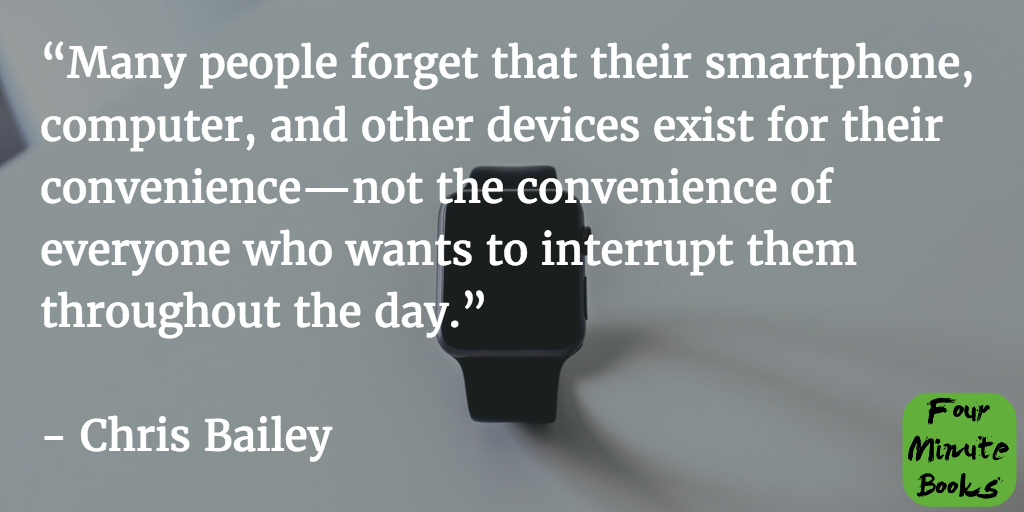1-Sentence-Summary: The Productivity Project recounts the lessons Chris Bailey learned over the course of a year running various productivity experiments to help you get more done in all areas of your life.
Read in: 3 minutes
Favorite quote from the author:

Audio Summary
Listen to the audio of this summary with a free reading.fm account*:
I used to look for the perfect productivity system. When I first embarked on improving how I work, I thought I’d just have to find the one set of rules that works. Of course there is no such thing. I transitioned to trying to assemble the one set of rules that works for me. But even that doesn’t exist.
We all need different rules at different times. Keeping this in mind, there is still reason to thank people like Chris Bailey, who sacrificed a year of his life in service of experimenting with productivity. In his book, The Productivity Project, he compressed everything he learned from his sabbatical, so you can make better tweaks to your own productivity.
From watching 296 TED talks to working 90 hours a week to waking up at 5:30 AM, he’s done it all and he found a philosophy, strategy and tactics that improved his productivity. Maybe these 3 can help you too:
- Productivity is about managing your time, energy and attention.
- Try organizing your work around the Rule of 3.
- The 40-hour workweek has its rightful place.
Our biggest human advantage is that we can simulate and learn from others, without having to use trial and error. Let’s put that skill to good use!
Lesson 1: Think of your productivity in terms of energy, time and attention.
The New York Times once called Tim Ferriss “a cross between Jack Welch and a Buddhist monk.” Chris suggests that’s exactly what you want to be. Neither as frantic and distraught as a Wall Street trader, nor as slow and perfectionist as a cleric.
There’s a fun analogy about life’s curse concerning energy, time and money: When you’re young, you only have energy and time, when you’re grown up, you have energy and money, but lack time and when you’re old you have money and time, but no energy.
Productivity from Chris’s perspective is similar: you can’t run on just energy and time or time and attention. You need all three.
- Energy comes from your health. If you’re too weak to work, all else is meaningless.
- Time is a skill you can learn. It’s about managing your priorities.
- Attention is what makes having the other two worthwhile. If you spend all your time and energy chasing distractions, that’s no good either.
Therefore, productivity becomes a mix of health, time management and designing your environment to reduce distractions. Let’s look at one of the tool’s he found for time management.
Lesson 2: The Rule of 3 could help organize your schedule.
In a book by a Microsoft executive called Getting Results the Agile Way, Chris found a way to chunk his goals into more achievable milestones. It’s called The Rule of 3 and prompts you to think in three time frames:
- What three things do you want to accomplish today?
- Which three milestones do you want to complete this week?
- What three goals do you hope to achieve this year?
Answer the first question on a daily basis to make sure what you do aligns with your weekly goals. This’ll also help check how your weekly targets relate to the big picture. This is a full productivity system in a nutshell, but it needs one tool to function: your calendar.
When planning your daily and weekly tasks, make sure the size of the chunks you pick doesn’t collide with what’s already in it, like birthdays, car repair appointments, and the other necessities of life.
Pro tip: Adding a 50% time buffer is a great way to make sure you don’t overestimate what you can accomplish in a given time period.
Lesson 3: There’s a reason most businesses follow the 40-hour workweek.
While in no means originating from scientific research, the 40-hour workweek actually happens to live up to academic scrutiny. In his experiments, Chris went all the way from 20 hours of work per week to 90 and found he accomplished more or less the same in both extremes.
Thus, he thought, he might as well pick the middle and work somewhere from 40-50 hours. The studies he looked at confirmed his approach, showing a steep decline in workers’ productivity after crossing the 55 hour mark. After 60, it even takes us twice as long to accomplish whatever task!
Of course you have to find your own rhythm here, but the gist is: neither extreme slacking nor a burnout work ethic will lead to much more accomplishments at work – so take it easy!
The Productivity Project Review
The most important lesson I’ve learned so far about productivity is that it’s fluid. Don’t try to nail it to one standard. In the same sense, don’t pick up this book expecting the golden goose of getting things done. See it like Chris did: as a series of experiments. Pick which ones you want to run and which ones you want to skip, based on his experience.
Don’t be afraid to keep revising and going back to this and other productivity books either. Chances are you’ll need a different system at a different time. With a take-what-works approach, The Productivity Project can make a valuable contribution to your work.
Who would I recommend The Productivity Project summary to?
The 21 year old college student with enough time to optimize his productivity now, before his real career starts, the 42 year old product manager, who feels worn out from work and anyone who doesn’t like waking up early.
Last Updated on August 11, 2022